In any work setting, collaboration and communication are the backbones of progress and success. They represent two sides of the same coin — they need each other to coexist.
But, when we combine these two, we get collaborative communication, a type of communication that makes it easy to work in a team and achieve a certain goal.
In this blog post, you’ll get to:
- Find out what collaborative communication is.
- Look at some examples of collaborative communication.
- Understand why it’s important.
- Read some handy tips on enhancing collaborative communication.
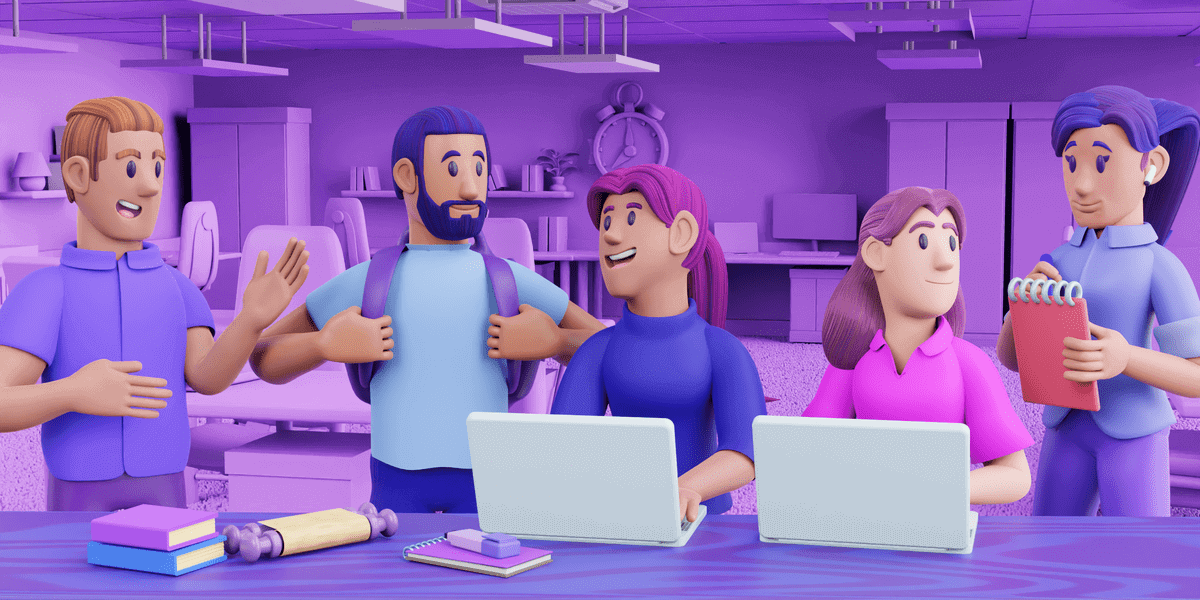
Table of Contents
What is collaborative communication?
In the Oxford Dictionary, collaboration is defined as “the act of working with another person or group of people to create or produce something.”
The same dictionary defines communication as “the activity or process of expressing ideas and feelings or of giving people information.”
When we put these two together, we get collaborative communication — the act of sharing information and expressing ideas while working together to achieve a common goal.
For a more comprehensive explanation about collaborative communication, we consulted Sara Garcia, a collaboration and communication expert. As someone who specializes in human behavior, Garcia confirmed our initial thoughts:

“Collaborative communication is any communication (verbal or non-verbal) that helps individuals work better together than they would alone, and therefore assists in achieving company goals.”
According to Garcia, collaborative communication often expands to include:
- Continual feedback
- Problem-solving
- Listening
- Empathy
- Creative conflict
Now that you’ve learned what it is, taking a look at some examples of collaborative communication can provide further clarification.
Examples of collaborative communication
For the purposes of this blog post, we’ll list examples of collaborative communication from the following industries:
- Healthcare
- Software development
- Education
An example of collaborative communication in healthcare 🏥
Nurse Joan is on call at the General Hospital. She has a patient whose condition is rapidly deteriorating and who is in need of quick attention. Nurse Joan can’t find any doctor to consult them about the steps she should take to help her patient.
Even though it’s 3 a.m., Nurse Joan quickly decides to call Dr. Green to get further instruction about what she should do. After giving him a thorough update on the patient’s condition, Nurse Joan proposes the therapy she believes could help the patient until a doctor comes to check up on her.
Dr. Green confirms that’s a good choice and encourages Nurse Joan to apply the therapy. He tells her not to worry because he is on his way to the hospital. He also sends out an emergency message to other doctors from his team and asks them to come immediately to the hospital.
Thanks to Nurse Joan’s quick reaction and Dr. Green’s skilled approach to the situation, the patient’s life is no longer in danger.
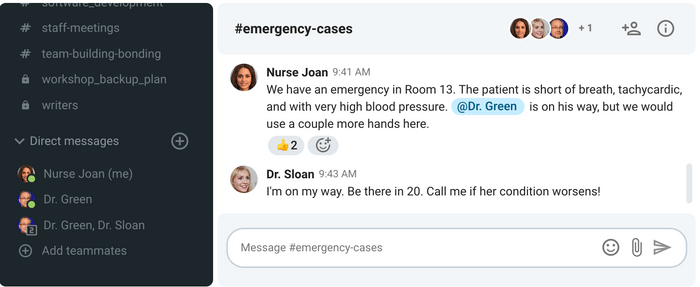
An example of collaborative communication in software development 🏢
George is a software developer in a company that offers several web-based products and mobile phone applications in the fitness and health industry, such as a period tracking app and an exercise app.
During one of the regular system maintenance check-ups, George notices a problem with these two apps that need immediate attention. He knows that he won’t be able to fix the issues alone, so he calls two other software developers to help him.
George explains the issue to other developers and they agree everyone should focus on fixing specific issues — so they assign roles to speed up the process. One hour into the fix, the apps are up and running.
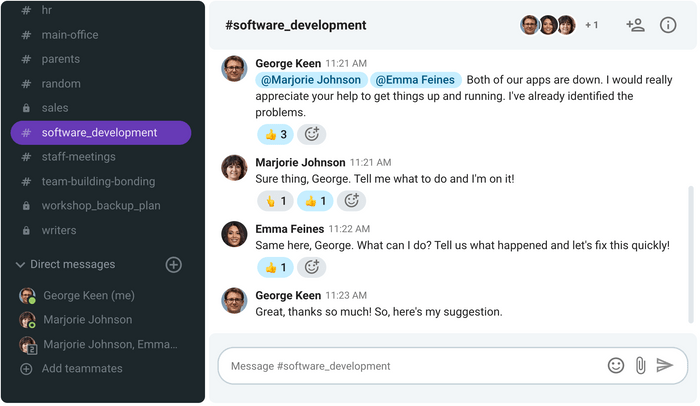
An example of collaborative communication in education 🏫
Marcus is a history teacher at a primary school. He has been tasked with organizing a workshop for his colleagues titled “The role of communication in education”. He plans a presentation together with an expert on communication who agrees to deliver a speech at the event.
On the day of the workshop, the expert he asked to speak at the event tells him they can’t make it to the event as the roads are blocked due to heavy snow. Marcus immediately sends out a message to his colleagues to put in motion his backup plan.
As previously planned, Gina, the English teacher, and Derek, the PE teacher, fill in for the expert. Marcus has already thought of potential problems and arranged for Gina and Derek to help him out in case something goes wrong.
Thanks to careful planning and effective communication through adequate communication tools, Marcus manages to deliver a great workshop to his colleagues.
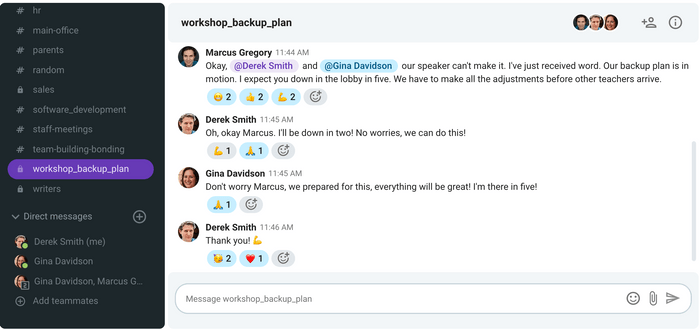
Why is collaborative communication important?
In any work setting, well-organized teams work effectively and make progress thanks to collaborative communication. With the rise of collaborative leadership, the importance of collaborative communication becomes even greater. Garcia remarks:

“Teams are the bedrock of a company and the degree of collaboration within and between teams is a measure of an organization’s success. Communication that facilitates this drives trust, relationships, learning, and goal achievement.”
She further explains that collaborative communication “facilitates and speeds progress.”
To fully understand its importance in the workplace, let’s point out a few more benefits that come with collaborative communication:
- It breaks hierarchical barriers.
- It streamlines work processes.
- It supports remote, hybrid, and distributed teams.
- It promotes better decision-making and problem-solving.
- It allows team members to learn from each other.
- It helps employees give and achieve more.
- It improves everyone’s adaptability to change.
- It supports a better employee experience, engagement, and loyalty.
- It boosts employee productivity and efficiency.
- It creates a positive workplace culture and atmosphere.
- It helps attract and retain top talent.
- It creates a happier and healthier workforce.
- It increases profitability.
While knowing all the benefits of collaborative communication is a good start for improving collaboration and communication in the workplace, you’ll also need actionable advice to make it happen.
Here’s what you can do to help your team communicate collaboratively.
How do you communicate collaboratively?
With a few tweaks to your internal communication strategy, you can really make a difference and help your people communicate collaboratively. We’ve got some handy tips for you.
👉🏽 Understand and respect differences
Garcia believes that understanding that other people aren’t like you is a crucial moment for all business professionals. Take for example multi-generational and cross-cultural companies — without collaboration and communication, diverse productive teams wouldn’t exist there.
According to research published by Bersin by Deloitte, companies with highly diverse teams enjoyed 2.3 times higher cash flow per employee. So, acknowledge and celebrate differences in your team — the more perspectives you have, the more likely you are to succeed in the long run.
💡 Pumble Pro Tip
Workplace communication is quickly changing to adapt to the needs of diverse teams. Take a moment to read a few lines about the use of emojis in workplace communication:
👉🏽 Learn to empathize and listen actively
According to a 2020 State of Workplace Empathy Report, 76% of employees believe an empathetic organization can inspire more motivated employees. Empathy is a great enabler of collaborative communication and the backbone of meaningful relationships.
Garcia agrees that everyone should always be ready to empathize:

“Put yourself in their shoes and empathize with their situation.”
Empaths are naturals at active listening and effective communication. So, the more you learn to take a step back and listen to the other side, the more likely you are to succeed in creating a positive atmosphere for information sharing and collaboration.
👉🏽 Use collaborative platforms to your advantage
According to the Gartner Digital Worker Experience Survey, almost 80% of employees were using collaboration tools for work in 2021.
It’s not surprising that the spread of hybrid communication has increased the demand for the tools that can support it and ensure real-time communication and constant collaboration.
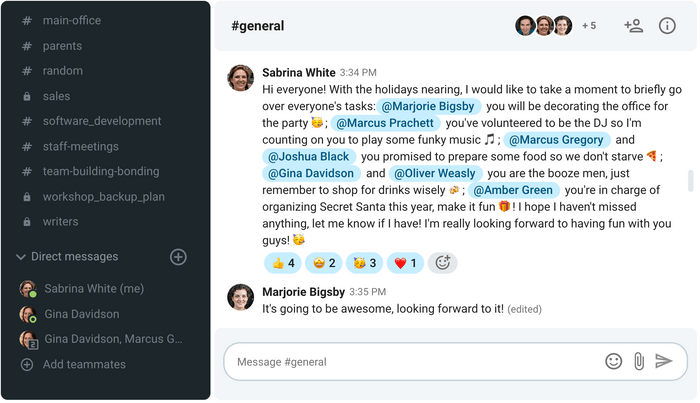
Remote, distributed, and hybrid teams heavily rely on tools such as:
- Business messaging apps: These facilitate real-time communication and minimize the use of email.
- Video conferencing apps: Regular and ad-hoc video calls are a breeze among virtual teams with a proper video conferencing tool.
- Time tracking tools: Remote and distributed companies make use of modern time-tracking tools to keep a record of their employees’ use of time.
- Document sharing platforms: These platforms make document-sharing in the virtual business world safe and easy.
- Project management tools: Having a platform like Plaky and ClickUp that categorizes all projects and tasks makes it much easier to keep track of what your people do and when.
- Graphic design editors: Visuals have become an essential part of effective communication among employees working across several countries and time zones.
- Virtual presentation software: These tools create the illusion of a conference room and allow remote and hybrid teams to present their work as if they were in the same room.
💡 Pumble Pro Tip
Regardless of the type of work model you’ve implemented, business messaging apps like Pumble can help your team stay connected at all times. Check out Pumble’s offer here:
👉🏽 Communicate respectively and transparently
Communication should by default be transparent and respective, regardless of the type of work arrangement or the people themselves. After all, a great part of what we do depends on the way we communicate daily with the people we spend time with at work.
Imagine you are about to break the deadline for a pressing project.
What do you do?
Well, you have two options:
- Option #1: You can keep the information about this problem to yourself, risk breaking the project deadline anyway, and impact the workflow of your entire team.
- Option #2: You can talk to your teammates and explain what the problem is. You express respect to their responsibilities and ask only those available to help you finish the project in time.
👉🏽 Avoid information overload
The Relevance Report 2021: Workplace by Coveo showed that 41% of all information employees receive at work isn’t relevant to their job role. When employees are overwhelmed with irrelevant information, they become disengaged and find it harder to commit to their daily tasks.
Beware, though. Information overload isn’t the same as overcommunication. While information overload has the employees fall victim to absorbing excessive and poorly-timed information, overcommunication proves essential in times of crises and major changes.
👉🏽 Assign roles and communicate expectations
Being clear about what you expect from your employees is paramount for seamless workflow and positive communication. Communicating expectations can:
- Remove ambiguity.
- Ensure employees have more autonomy and flexibility.
- Minimize stress and increase employee engagement.
- Make employees feel confident and satisfied.
- Improve overall communication and collaboration.
So, before you assume anything the next time you communicate with your team, take a moment and remember that not all “goes without saying”.
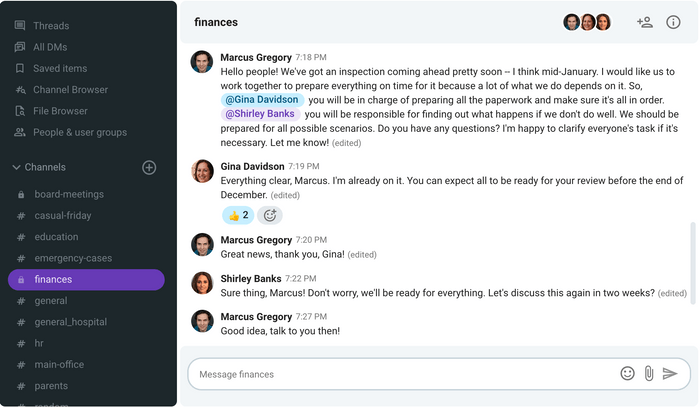
👉🏽 Find ways to help each other
A Zippia report on Workplace collaboration found that about 75% of employees consider teamwork and collaboration as very important.
When working with others, committing to helping each other in times of crisis is a precursor to a more productive and more connected team. It’s also the road to constantly moving forward, believes Garcia:

“Find ways to help each other with your goals and communicate with respect and in a timely manner so there is continuous progress.”
Let’s look at this example:
🔸 Example: You notice your teammate is struggling to complete her daily tasks so she works overtime every day. You approach her and offer help even though you have a lot on your plate, too. Working together, the two of you finish a month’s worth of work in just a week and go back to your regular daily tasks and responsibilities.
As you can see, joining forces proves like a win-win situation. It’s great to always have someone to count on, especially when you find yourself swamped with work.
👉🏽 Invest time in creating a collaborative culture
Companies that prioritize their collaborative culture are committed to nurturing collaboration, constantly and on purpose. This is achieved through the nonstop reliance on collaboration for all projects and daily tasks.
A collaborative culture is built on:
- Leaders who live and breathe collaboration
- Transparency and selfless knowledge sharing
- Honest and mutually respectful relationships
Moreover, instilling the principles of collaborative culture into your people will make them permanently stick in the workplace, too.
Additionally, learning how different communication models illustrate the communication steps shaping this and other types of communication can also be instrumental to understanding how to foster collaborative communication and culture at your organization.
💡Pumble Pro Tip
Building a collaborative culture can be easy with the right approach. Check out our text for more tips on how to do it:
👉🏽 Embrace creative conflict
When I consulted her about collaborative communication, Garcia put special emphasis on the importance of creative conflict in collaborative communication. She further explained her point of view:

“Creative conflict is a high state of collaboration where trust exists at an increased level and communication skills are strong. It allows us to respectfully disagree with each other, listen, be flexible in our thinking, so we can come to better solutions.”
Avoiding conflict in the workplace can only do harm to your team and to the entire company. So, steer clear from the “we put problems under the rug” approach when it comes to workplace conflict. Instead, create a safe environment that promotes creative conflict as a desirable workplace practice.
💡 Pumble Pro Tip
Navigating conflict in a healthy and constructive manner at work can be much easier with these 15 useful phrases:
👉🏽 Organize regular meetings and check-ups
When teams work together to complete a project, they want to see each other more often — to avoid miscommunication and ensure they have all the information.
Meetings have for long been a regularity for in-office workers who (usually) see each other every day. But, virtual teams have it much easier now, too. Organizing business meetings for remote and hybrid teams has become a matter of a few clicks.
Meeting on a weekly or even daily basis can also help reduce the effects of FOTO and FOMO in your hybrid workforce. And, to make it even more fun, you can attend meetings and work on tasks from the comfort of your own home.
👉🏽 Build trust among employees
According to the Trust in the Modern Workplace Report issued by the Workforce Institute, trust is an integral part of happy and healthy organizations. Dr. Chris Mullen, Ph.D., SPHR, SHRM-SCP, and executive director at the Workforce Institute, writes in the introduction of the report:
“There is an intimate connection between trust and belonging in the workplace. How can we expect anyone to develop a strong sense of belonging at work if they don’t feel trusted by their peers, managers, and leaders?”
According to the report, as much as 74% of employees would work for a company they find trustworthy. When people feel there’s no trust in the relationships they form at work, it negatively affects their productivity, decision-making, and problem-solving skills.
So it’s not enough to have your people communicate and collaborate every day. Cultivating trust in workplace relationships will ensure your people are more comfortable working with each other, too.
Dr. Mullen, explains why trust is essential to any organization:
“Trust must constantly be nurtured, and when the organization’s default position is to presume trust and good intentions, they can reimagine outdated processes and policies to focus on driving performance through a truly modern employee experience.
Trust makes it safe to pursue new innovations and challenge the status quo. It’s a critical element to deliver meaningful and connected experiences.”
👉🏽 Be willing to compromise
A compromise is a kind of “middle ground” or a mutually acceptable solution to a disagreement between people (two or more). As such, compromise can be a powerful tool for learning what’s important in team communication and collaboration.
You can rely on compromise in situations like:
- Strategy-planning meetings,
- Distributing roles among team members, or
- Salary negotiations.
Moreover, once you teach your team how to compromise, you’ll equip them with a life-changing skill. They will be able to:
- Resolve their arguments easier.
- Come up with solutions much quicker.
- Tackle challenges effectively.
- Get along with each other better.
👉🏽 Show gratitude for individual contribution
Let’s recall the multi-generational and cross-cultural teams for a second — the chances are high that people in these teams will be doing things differently and having a harder time adjusting to each other.
With such teams, each team member should be encouraged to contribute their best to the team. When people are allowed to be their true selves at work and appreciated for what they are, they become high-spirited and are ready to go above and beyond for their team.
According to a study from Harvard University and Wharton, getting a “Thank you” from a manager boosted employee productivity by over 50%.
So, get into the practice of showing how grateful you are to have your team. If you model gratefulness, your teammates will follow suit.
👉🏽 Normalize constructive feedback practices
Companies that have a great open-door policy are already doing their best to minimize the stigma about feedback — they have created an open work environment where voicing concerns and giving feedback are considered desirable rather than suppressed.
This particularly applies to collaborative teams who work together on various tasks and projects. As long as it’s given at the right time and in the right manner, feedback is good and here’s why:
- It increases motivation: As employee feedback statistics reveal, 43% of highly engaged employees enjoy feedback at least once a week.
- It boosts confidence: Workplace communication statistics (2021) showed that people are 4.6 times more likely to feel empowered to do their best if they feel heard and appreciated.
- It makes room for better performance: According to the previously mentioned Workplace communication statistics, 92% of employees believe that feedback can boost their performance when delivered in a proper way.
- It supports personal growth: Employees want more feedback because it helps them acknowledge their strengths and weaknesses. Once they become aware of these, people find it easier to work on growing both professionally and personally.
- It fosters stronger relationships: When honest and constructive, feedback opens the door for better workplace relationships. If people know they can come to their manager with any problem and be heard, they will feel more comfortable doing it.
- It promotes continuous learning: About 65% of employees say they want more feedback. The more feedback they get, the more opportunities they have to learn and improve their knowledge.
👉🏽 Remember to have fun along the way
If you want your team to be highly collaborative, think about practicing some of the many team-building and team-bonding activities.
Let’s remind ourselves why these are essential for supporting collaborative communication:
- Team building is defined as the process of turning a group of individuals into a cohesive team that works toward a shared goal. We can thank team building for creating stronger relationships, fostering respect, and diversity among team members.
- Team bonding represents an ongoing process that facilitates trust-building and ease of communication among team members. A great way to employ team bonding is by engaging in fun activities that allow team members to enjoy and share positive experiences.
Even if you haven’t organized any team-building or team-bonding activities for your team before, now is a good time to consider it.
Summing up: “Alone, we can do so little; together we can do so much.”
As Hellen Keller wisely said, doing things together brings much more than doing things alone. This translates to literally any aspect of life — including workplace communication.
Establishing collaborative communication doesn’t require a lot — but it can bring so much to the entire team and each team member. If you want your team to communicate collaboratively and be as productive as possible, they have to learn it from someone — and it’s best if they learn it from you.
So, model the communication you want to achieve in the workplace and your people will find it easier to follow.




